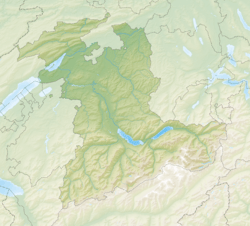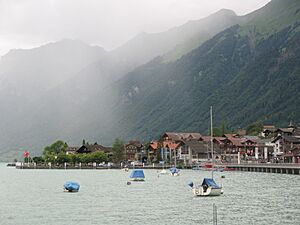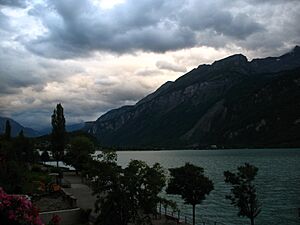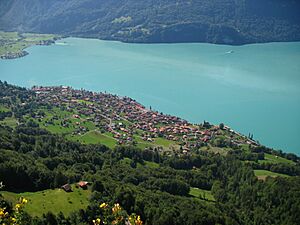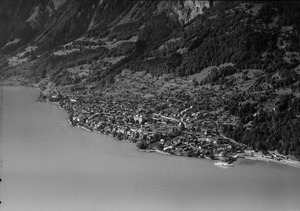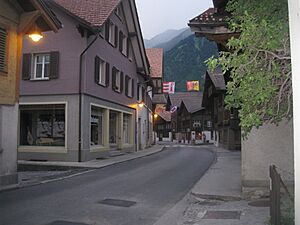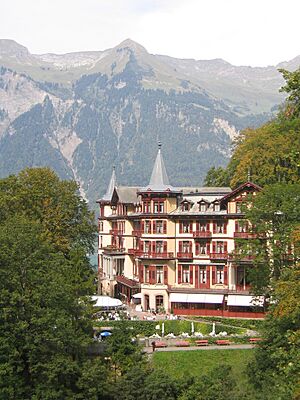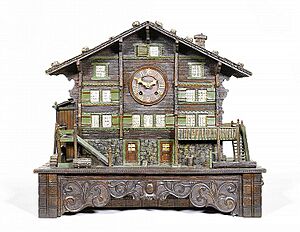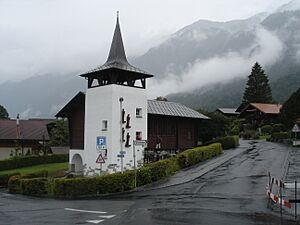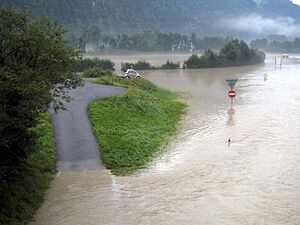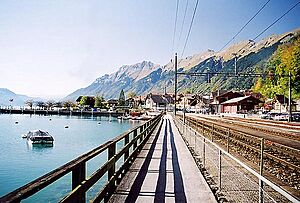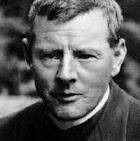Brienz facts for kids
Quick facts for kids
Brienz
|
||
|---|---|---|
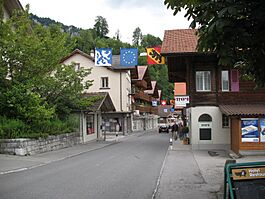 |
||
|
||
| Country | Switzerland | |
| Canton | Bern | |
| District | Interlaken-Oberhasli | |
| Area | ||
| • Total | 48.06 km2 (18.56 sq mi) | |
| Elevation
(Brienz village)
|
566 m (1,857 ft) | |
| Highest elevation
(Schwarzhorn)
|
2,928 m (9,606 ft) | |
| Lowest elevation
(Lake Brienz shore)
|
564 m (1,850 ft) | |
| Population
(Dec 2020 )
|
||
| • Total | 3,158 | |
| • Density | 65.710/km2 (170.19/sq mi) | |
| Postal code |
3855
|
|
| Surrounded by | Brienzwiler, Flühli (LU), Grindelwald, Hofstetten bei Brienz, Iseltwald, Meiringen, Oberried am Brienzersee, Schwanden bei Brienz | |
| Twin towns | Brienz/Brinzauls (Switzerland), Tryavna (Bulgaria), Shimada (Japan) | |
Brienz is a charming village and municipality in Switzerland. It sits on the northern shore of Lake Brienz, right at the foot of the Brienzer Rothorn mountain. You can find it in the beautiful Bernese Oberland region.
Besides the main village of Brienz, the municipality also includes smaller areas like Kienholz and Axalp. It's part of the Interlaken-Oberhasli administrative district in the canton of Bern.
Contents
History of Brienz
People have lived in the Brienz area for a very long time, even since the neolithic (New Stone Age) and Bronze Age. Around 500 BC, the Celts settled in the nearby alpine valleys. Later, the Romans took over the area in the late 1st century BC.
However, in 259/260 AD, the Alamanni destroyed the Roman settlements. The Alamanni then settled here themselves around 450 AD. We know this because evidence of their settlements from the 7th century has been found.
Brienz was first mentioned in official records in 1146. After many changes over the years, Brienz became part of the Canton of Bern in 1528.
Lake Brienz has likely been used for travel for thousands of years. The first steamship started operating on the lake in 1839, connecting Interlaken and Brienz. In 1888, the Brünig railway opened, linking Brienz to Alpnachstad on Lake Lucerne. This made Brienz an important stop for people traveling between Interlaken and Lucerne by boat and train. By 1916, the railway line was extended all the way to Interlaken.
Geography of Brienz
The municipality of Brienz covers an area along the upper part of Lake Brienz and extends into the nearby mountains. It includes the main village of Brienz on the right side of the lake, and the village of Kienholz near where the Aare river flows into the lake. On the left side of the lake, you'll find the settlements of Engi and Schwendi.
From the right side of the lake, the land rises up to mountains like the Rotschalp, Planalp, and Giebelegg, eventually reaching the Brienzer Rothorn mountain, which is about 2,351 meters (7,713 feet) high. From the left side, the land goes up past the Brienzerberg and Giessbach Falls, through areas like Tschingelfeld and Hinterburg, all the way to Axalp and the Schwarzhorn mountain, which is about 2,928 meters (9,606 feet) high.
Brienz has a total area of about 48 square kilometers (18.5 square miles). A large part of this land, about 38.6%, is used for farming. Forests cover another big part, about 33.7% of the area. About 4.5% of the land is built up with buildings and roads.
Brienz's Coat of Arms
The coat of arms for Brienz shows a wavy line that divides the shield into two parts: one blue and one silver. On top of this, there's a lion standing up, with its colors reversed (so it's silver on the blue part and blue on the silver part). Its tongue and claws are red.
People of Brienz
Brienz has a population of about 2,981 people (as of December 2010). About 8.8% of the people living here are from other countries.
Most people in Brienz speak German as their first language (about 92.9%). A smaller number of people speak French or Albanian.
In 2010, about 21.1% of the population were children and teenagers (0–19 years old). Adults (20–64 years old) made up 57.3% of the population, and seniors (over 64 years old) made up 21.6%.
Fun Things to See and Do
- Lake Promenade: During World War I, a beautiful walkway was built along the village and the lake shore. It's decorated with flowers and trees, and you can enjoy amazing views without any traffic.
- Brienz Rothorn Bahn: You can take a ride on the Brienz Rothorn Bahn, which is a special steam train that goes up the Brienzer Rothorn mountain. It's a unique experience!
- Ballenberg Open-Air Museum: This amazing museum is home to nearly 100 old buildings from all over Switzerland. It's like stepping back in time to see how people used to live.
- Wood Carvings: Brienz is famous for its wood carvings. You'll see many beautiful examples of this traditional craft.
- Giessbach Falls: Visit the stunning Giessbach Falls and ride the Giessbachbahn, which is the oldest funicular (a type of railway that goes up a steep hill) in Europe.
Important Historical Sites
The old alpine village of Axalp and the Giessbach Hotel Complex are very important historical sites in Switzerland. The village of Brienz itself and the Giessbach Hotel are also recognized as important heritage sites. The Giessbach Hotel was even used as a filming location for the TV series 'Band of Brothers'.
Economy of Brienz
The main activities in Brienz are tourism and woodcarving. The Cantonal Woodcarving School, which started in 1862, is very well-known and respected for teaching this craft.
A Swiss company called Lötscher makes the only real Swiss cuckoo clocks right here in Brienz. All the first steps of making these clocks happen in their woodworking factory in Brienz.
Many people in Brienz work in tourism, hotels, restaurants, and construction. Some also work in agriculture and forestry.
Religion in Brienz
Most people in Brienz are Christian. Many belong to the Swiss Reformed Church, and a smaller number are Roman Catholic. There are also people who belong to other Christian churches, and some who are Islamic, Buddhist, or Hindu. A small number of people do not belong to any church.
Climate in Brienz
Brienz gets a good amount of rain or snow each year. On average, it has about 138 days with precipitation and receives about 1,325 millimeters (52 inches) of rain or snow annually. July is usually the wettest month.
Education in Brienz
In Brienz, many people have completed their high school education, and some have gone on to higher education at a university or a specialized college.
The school system in the Canton of Bern starts with one year of optional Kindergarten. After that, students go to Primary school for six years. Then, they attend three years of lower Secondary school. After lower Secondary, students can choose to continue their education or start an apprenticeship to learn a trade.
During the 2010–11 school year, there were 363 students in Brienz. This included students in kindergarten, primary school, and lower secondary school.
Transport in Brienz
The Brienz railway station is the main place for public transport in the village. Trains on the Brünig railway line stop here, connecting Brienz to Interlaken and Meiringen, and also to Lucerne. There's also a smaller station called Brienz West railway station nearby.
Right across from the main train station, you'll find the lower station of the Brienz–Rothorn rack railway. This special railway operates only in summer and takes you up to the top of the Brienzer Rothorn mountain. What's cool is that most of these trains are pulled by steam locomotives!
Also in summer, boats from BLS AG operate on Lake Brienz. They stop at a pier next to the Brienz railway station, connecting Brienz to various points on the lake, including the Giessbach Funicular, which takes you to the beautiful Giessbach Falls.
PostBus Switzerland services also connect Brienz village to other local places, like the Ballenberg open-air museum.
Twin Towns
Brienz has special connections with other towns around the world, called "twin towns" or "sister cities":
Notable People from Brienz
- Elisabetha Grossmann (1795–1858), known as "The Fair Skipper of Brienz."
- Oswald Wirth (1860–1943), an occultist, artist, and writer.
- Heinrich Federer (1866–1928), a Catholic priest and writer.
- Rosa Neuenschwander (1883–1962), a pioneer in vocational education and a feminist.
- Fritz Abplanalp (1907–1977), a Swiss woodcarver.
- Anita Studer (born 1944), an accountant, ornithologist, and conservationist who is working to save a forest in Brazil.
- Martina Schild (born 1981), an alpine downhill skier who won a silver medal at the 2006 Winter Olympics.
Images for kids
See also
 In Spanish: Brienz para niños
In Spanish: Brienz para niños




